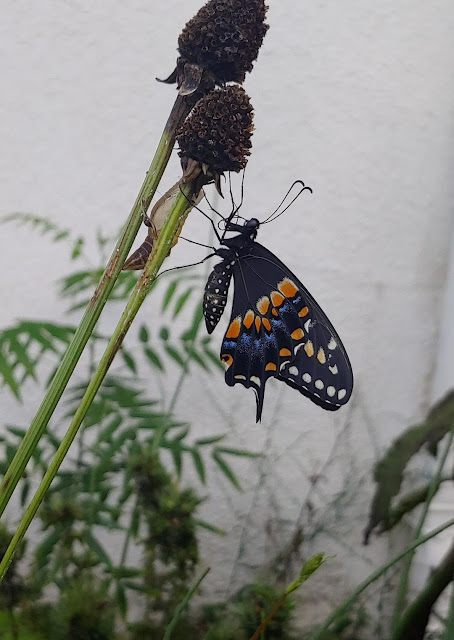Natives vs Nonnatives - Eastern Black Swallowtails
 |
| Newly emerged eastern black swallowtail |
A couple of days ago, the last of my newest set of eastern black swallowtails emerged from their chrysalises in my landscape. This time of year, their mother laid her eggs on my native water dropwort (Tiedemannia filiformis) that had recently begun blooming. Each fall, the butterflies find this plant as the blooms begin to develop and the caterpillars eat them to the nub. It's a ritual I anticipate and it's one that rarely leaves me with seed to propagate for my nursery, Hawthorn Hill. I have to collect seed in other areas where there are so many plants that at least some of them escape the herbivory. In my experience, water dropwort is the best native plant to feed eastern black swallowtails with and it is one I consider indispensable in every landscape I've planted since moving to Florida. The rub is that they only lay eggs on it in the late summer when it begins to bloom. Until that time, the plant is ignored.
This is true for a great many host plants. The sulfurs that use my sennas (aka cassias) or partridge peas (Chamaecrista spp.) ignore them when they don't have flowers, for example. In other cases, my host plants are left alone except at times when they are actively putting out new growth. The giant swallowtails tend to ignore my key lime like this. The periodic bursts of new growth that it puts on are always met by caterpillars. Butterflies recognize the most nutritious growth before wasting time putting the future of their offspring into the equation.
I'm not sure what the eastern black swallowtails do during the spring and early summer. I know that they occasionally use the mock bishopweed (Ptilimnium capillaceum) in my landscape and in areas where I see it growing wild, but this is an annual that is somewhat difficult to maintain in a planned landscape. It reseeds heavily in my nursery flats, but it doesn't do nearly as well in my landscape. Coupled with the fact that it is rather diminutive and rarely capable of feeding a caterpillar to its final stages without help from other plants nearby, makes it less than perfect in my mostly native plant landscape. This is where my nonnative plants come into play.
Some native plant enthusiasts shun nonnative plants. It has become a popular topic on various social media pages that I follow. The truth is that a plant's value is not based on its nativity, but on its function and several members of the carrot family (Apiaceae) serve an important function as host plants for my eastern black swallowtails. I keep a pot of curled parsley and one of fennel to feed them when my water dropwort is not of interest. Earlier this summer, both of them were eaten to the ground by the caterpillars. I found only 1 caterpillar on my mock bishopweed. Right now, with my water dropwort recovering from the recent denuding, both the parsley and the fennel are covered with eggs and 1st instar caterpillars. Without these nonnatives, I would have lost several broods of butterflies.
Plants are really not "native" vs "nonnative" in a living landscape, but useful or not. Many native plants I see folks touting on social media groups have very limited use to wildlife compared to others that could be used instead. Some of the alternate choices could be nonnatives. As we strive to create living landscapes, our primary goal should be to choose function over aesthetics and then function over nativity. Nearly all of my landscape choices are native - for a reason, but the nonnatives I've added provide function that I might not get otherwise.



Comments
Post a Comment